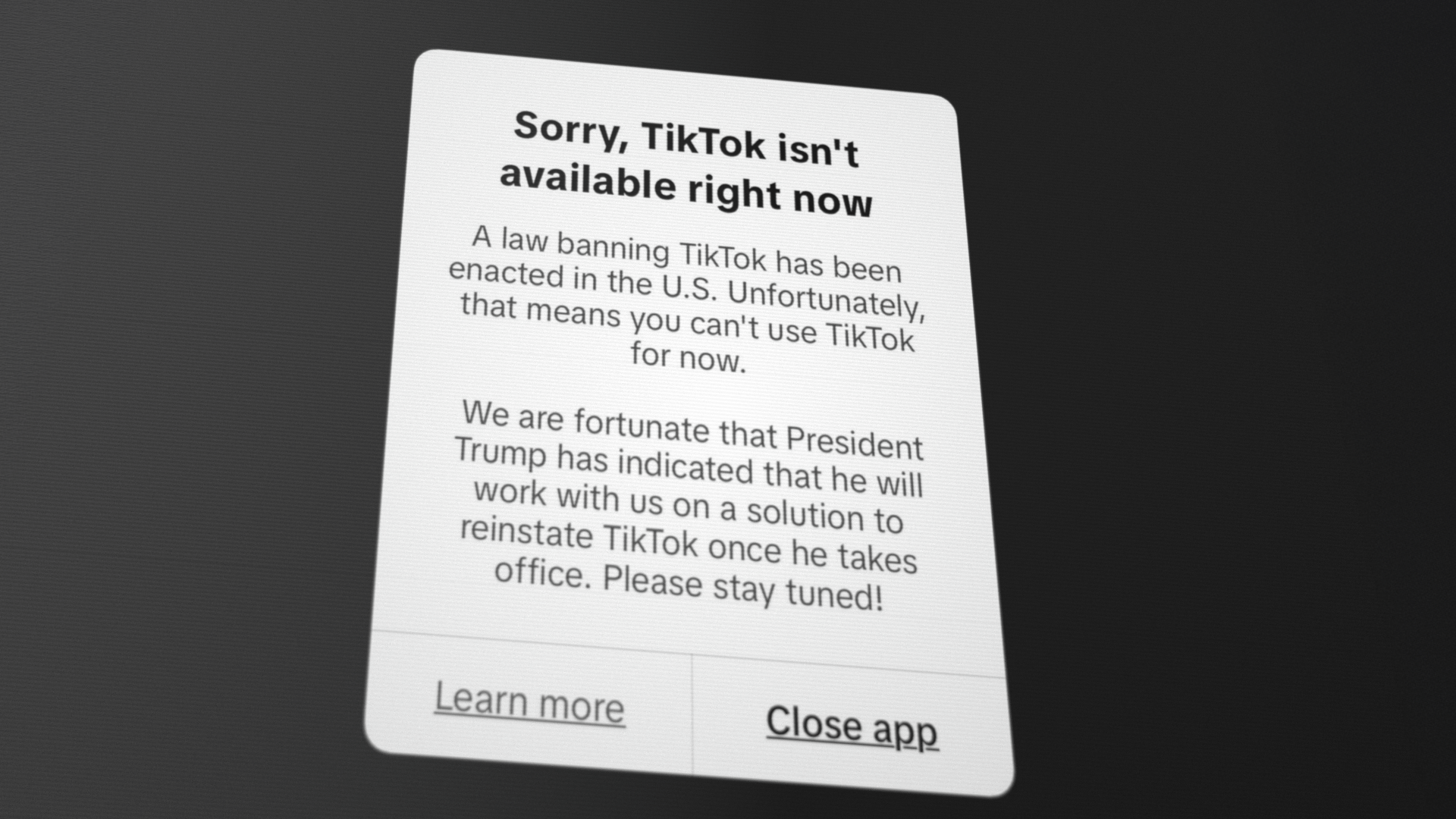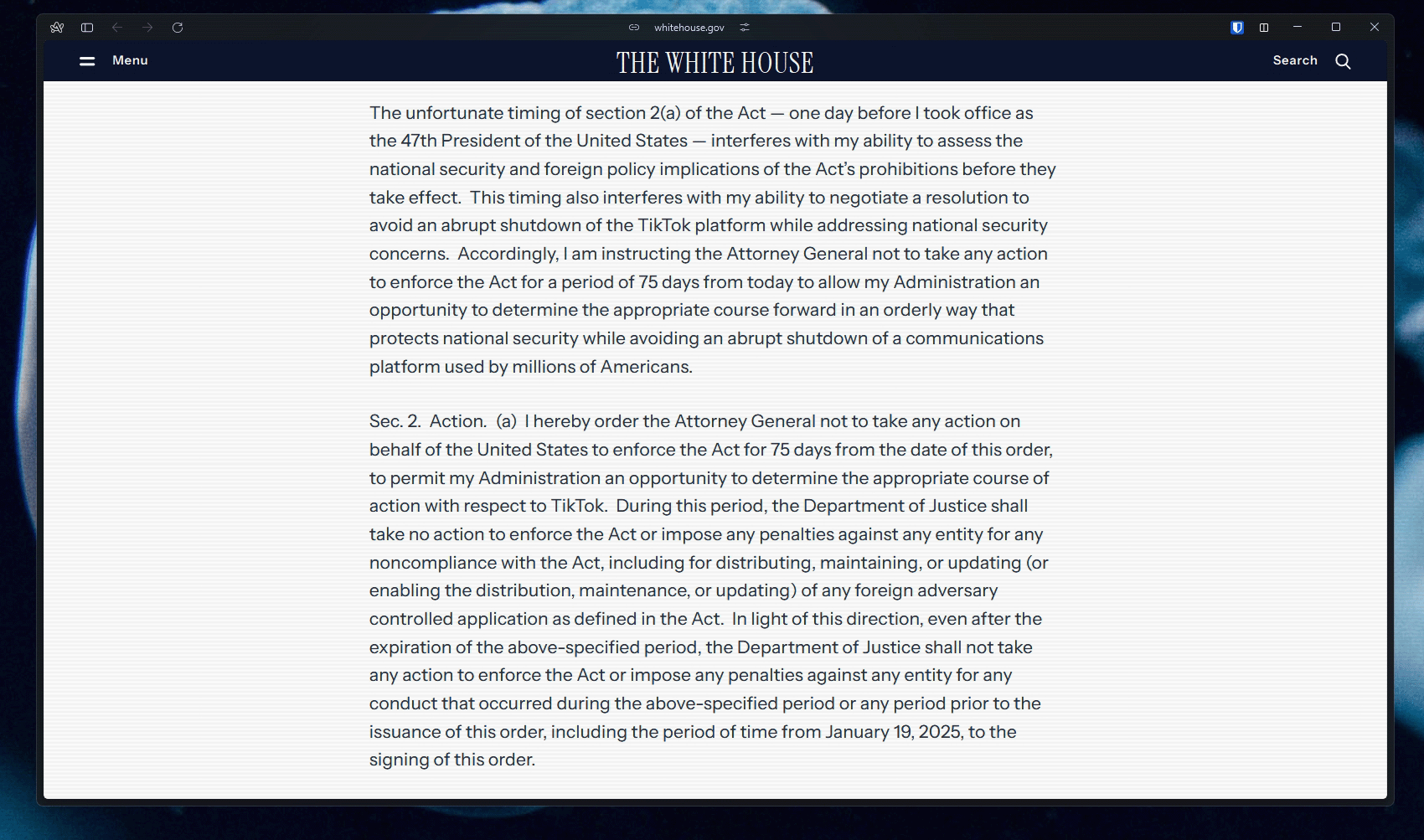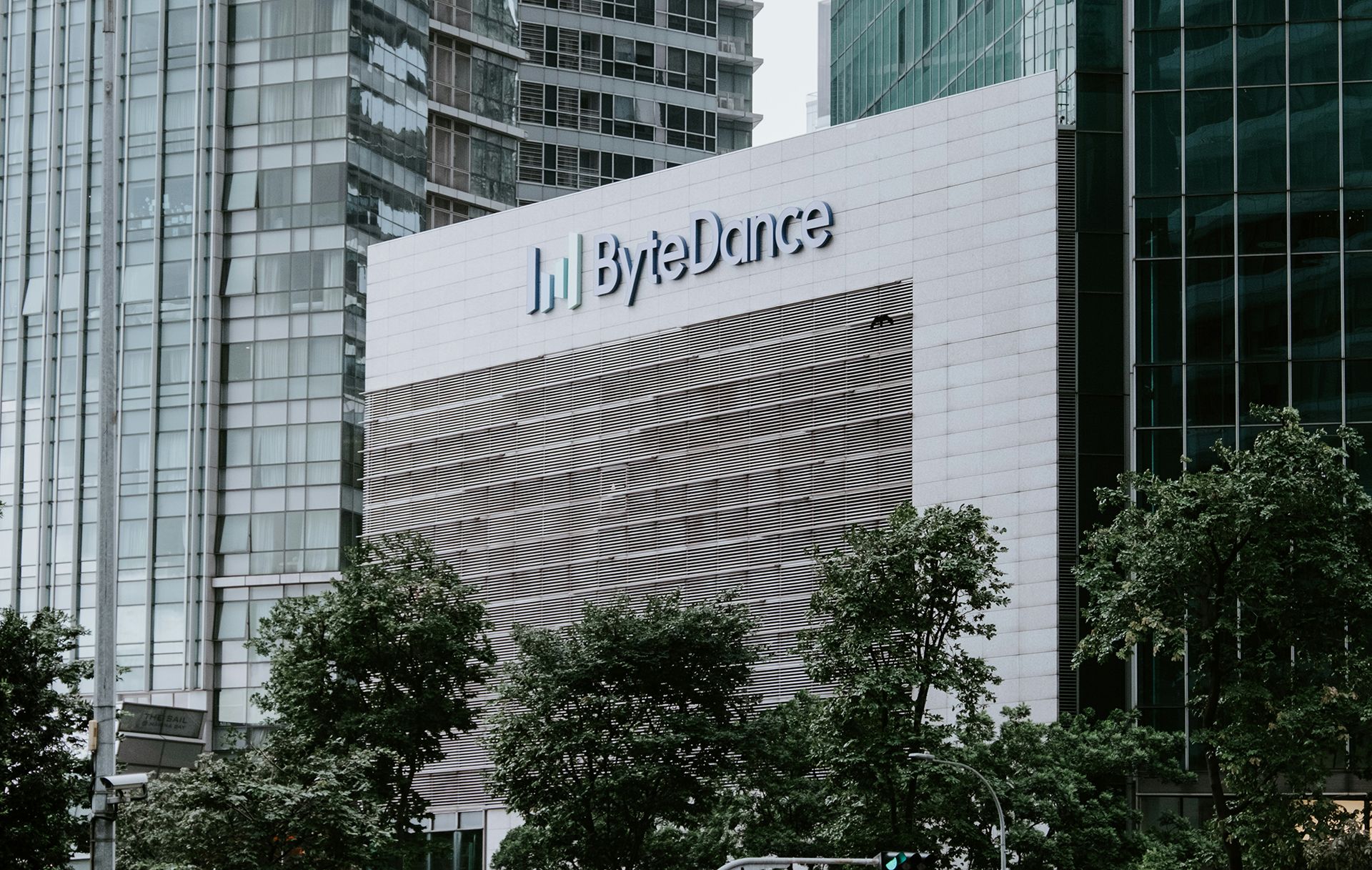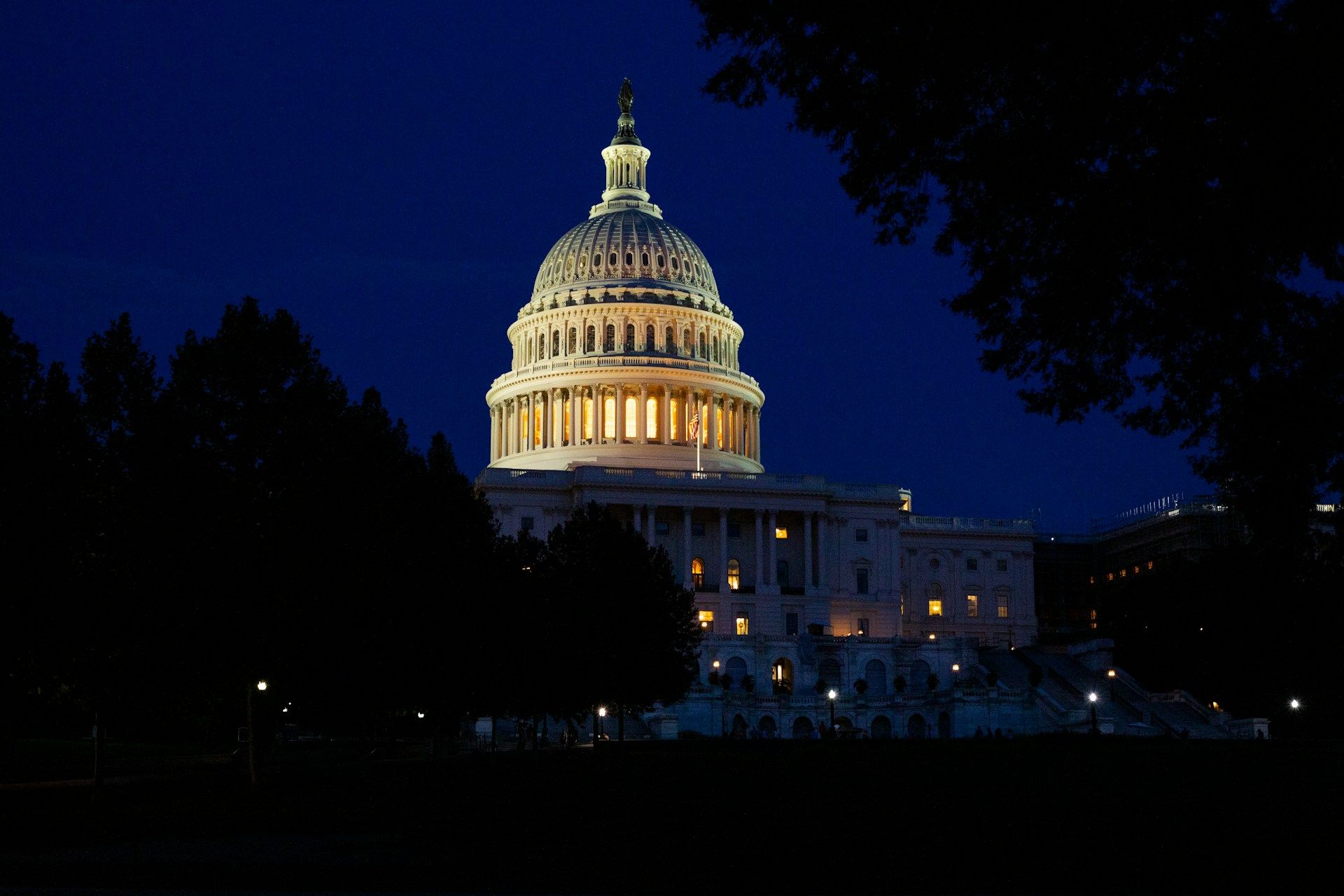On the evening of January 18th, TikTok dramatically shut down in the US, causing a mania among many of its users. Some turned to the closest app they could find, Redbox, while "TikTok VPN" started trending as a method to bypass the restriction.
Ultimately, the app's blackout was short-lived. After reassurances from then-president-elect Trump, its service was reinstated the next day. However, in the noise, a lot of detail was lost. Despite its respite, TikTok's future is very uncertain. So, too, is the public, with much context surrounding the impact of Trump's executive order and the broader implications of the so-called "TikTok ban" lacking.
What exactly can we expect from TikTok going forward? Might it be necessary to turn to VPNs once more? Let's start with a summary of everything that has happened so far.
A timeline of the TikTok ban

- October 2019: US politicians begin to call for a national security probe into TikTok following its Musical.ly acquisition and several questionable moderation choices.
- July 31, 2020: President Trump announces a decision to force TikTok owner ByteDance to divest its ownership of the application and threatens to shut down its U.S. actions via executive action on August 1 if it does not comply. Microsoft is reported to be in talks of acquiring TikTok.
- August 2, 2020: It is reported that Microsoft has paused its talks with TikTok. TikTok's manager of U.S. operations states that the company is "not planning on going anywhere". Later that day, talks resume, with Trump agreeing to put a 45-day hold on action against TikTok to the time to divest its ownership to Microsoft or another company.
- August 6, 2020: President Trump signs an executive order banning TikTok in 45 days if it is not sold. He cites "credible evidence" that the company may take action that threatens to impair U.S. national security.
- August 24, 2020: TikTok files legal action challenging the ban, citing lack of due process under the Fifth Amendment, lack of evidence that TikTok is a security threat, and more.
- August 29, 2020: China changes its export control rule to restrict the export of tech data gathering products such as TikTok. This complicates any TikTok sale despite insistence from officials that it is not explicitly targeted at TikTok.
- September 27, 2020: Filed on September 23, TikTok's preliminary injunction to temporarily prevent the app from being banned in the U.S. It is just hours before the ban is supposed to start.
- January 20, 2021: The Biden administration takes over. President Joe Biden signs an executive order revoking the TikTok ban, instead ordering the Secretary of Commerce to investigate the app to determine if it's a risk to national security.
- November 2022: Many lawmakers have now changed their minds and support a TikTok ban. This follows leaks in the media surrounding TikTok's data practices and the level of control from China. Statements from the FCC commissioner and FBI director also contribute.
- March 11, 2024: Trump reserves his position on TokTok, arguing that a TikTok ban would empower Facebook, which he calls an "enemy of the people".
- April 24, 2024: Biden signs a bill that includes a ban of TikTok in the US by 2025 if it does not divest its stake. An additional 90 days can be added to the deadline if needed.
- January 10, 2025: After several legal challenges by TikTok, the Supreme Court upholds that the TokTok ban is constitutional, and the ban will, therefore, take effect as planned.
- January 18, 2025: TikTok's app shuts down in the US, preceding the ban. It states that it is seeking assurances from the incoming Trump administration on whether it will be allowed to continue to operate. Several app stores remove TikTok from their listings.
- January 19, 2025: TikTok comes back online, stating that it has received the necessary assurances from Trump.
- January 20, 2025: Donald Trump starts his second term with an executive order delaying the ban by 75 days. His administration begins work on a deal that will grant the US 50% ownership in a joint venture.
Why TikTok's future is still uncertain

Though President Trump's actions have been taken by many as reversing the TikTok ban, the executive order only delays it by 75 days. At the current moment, the future of TikTok, as it has since this saga began, depends on whether ByteDance can make a deal to divest to US stakeholders.
So, how likely is a deal, and who is likely to make it?
The contenders for TikTok's throne

There are several rumored contenders for a 50% stake in ByteDance's social media platform. Oracle was one of the first reported, which makes natural sense given its prior involvement the fact that it almost won a bid for the platform in 2020. However, Trump has denied being in talks with the company, instead stating talks with numerous "Very substantial people".
One of those people may be billionaire Frank McCourt, who is leading an investor group that claims to offer "The People's Bid for TikTok". YouTuber Jimmy Donaldson (Mr. Beast) has also stated a serious intention to buy the platform, but media reports suggest they are not part of the rumored Oracle deal.
There has also naturally been speculation surrounding Elon Musk, who can certainly raise the capital and has recently inserted himself into Trump's inner circle in recent times. Concerns, however, may arise due to optics, given the spotlight shone on the billionaire at Trump's inauguration rally.
Perplexly AI has also reportedly submitted a bid for TikTok, looking to create a merged entity that combines itself, TikTok US, and other capital partners.
There are sure to be more players involved. Few companies and billionaires would turn down the offer to acquire half of one of the world's largest social media platforms. Google, Meta, and Microsoft are others who would no doubt stand to gain significantly from such a deal. Ultimately, however, any deal is more likely to be determined not by the highest bidder but by Congress.
The obstacles to a TikTok deal

Any TikTok deal will have to appease Congress. Specifically, the legislative branch must be convinced that any agreement will not allow ByteDance to covertly manipulate the app. According to a congressional staffer speaking to NPR, this means Congress is likely to prioritize companies without an operational relationship. You'd think that rules out Oracle, who is one of TikTok's leading data center providers. It is also likely ByteDance has a working relationship with Amazon's AWS, Akamai, and potentially Google Cloud.
A successful bid from these companies would likely include a plan to demonstrate no Chinese influence or access to the social media platform. Proving a negative, however, is famously difficult. Indeed, this was reportedly why a previous deal with Oracle fell through under the Biden administration.
Another challenge is the price tag. According to White House negotiators, ByteDance believes it could get at least $200 billion for the stake in its app. That figure is out of the reach of most investor groups. Even Elon Musk, with a net worth of $422 billion, would need to think long and hard about the decision.
Of course, the fact that ByteDance needs to sell or face a ban should drive the price down somewhat. However, the long and short of it is that while there are many interested parties, a successful TikTok deal is by no means guaranteed. Currently, no deal will mean no TikTok for US users. At least, not without workarounds.
TikTok VPNs
A big question for TikTok users is whether they'll be able to bypass the ban should it come back into effect. Thanks to the short blackout, we now have some answers on whether you can use a VPN to circumvent the ban.
If Tiktok is banned, can you use a VPN?

There's a good chance you'll be able to use a VPN to bypass the TikTok ban, should it come back into place. However, it may not be as simple as finding any VPN app and switching it on.
During the blackout, users reported that changing their IP address using a VPN did not magically make their app start working again. Instead, users report that the following process is required:
- Activate a VPN to a country of your choice. A Canada or a UK VPN are good options as they are English-speaking.
- Visit tiktok.com in an incognito tab and create an account using a new email.
- You should now be able to use TikTok using the new account in your browser when your VPN is enabled.
Restoring TikTok access via the app is more challenging. Some users reported that they needed to uninstall the app, activate a VPN, then install an APK and log in with their new account. However, it's worth noting that the TikTok app may use other data points to determine your true location. This includes your location and phone number/SIM card. Though users can use GPS spoofing for the former, the latter is more difficult to get around.
Of course, there is also the caveat that we don't know for certain how ByteDance and the US government would implement a fully-fledged ban. It's possible more aggressive methods would be used to prevent access than we have seen so far. Regardless, it's likely VPNs will play a key role in any bypass.
Is using a TikTok VPN legal?
According to the Electronic Frontier Foundation's Brendan Gilligan, you shouldn't get in trouble for using a TikTok VPN or other bypass methods. At the time of writing, the law is targeted at TikTok and its intermediaries, not at individual users.
It is possible, however, that this could change in the future. It's a good idea to use a VPN with a no-log policy or, even better, host one yourself so you can ensure that is the case.
What is the best VPN to bypass the TikTok ban?

Many users reported that they could not bypass the temporary TikTok ban using their mainstream VPN. This is because companies often ban IP addresses from known VPN providers to prevent circumvention and misuse.
As a result, you may want to set up your own VPN using a VPS provider. BitLaunch lets you launch WireGuard and OpenVPN servers in one click while maintaining your privacy. You can follow the guide below to get started.



